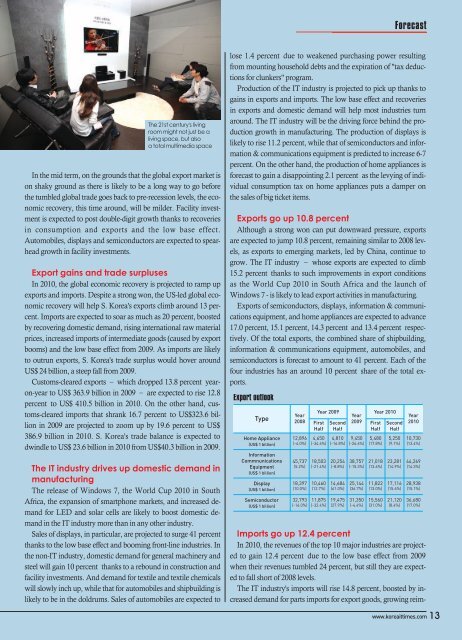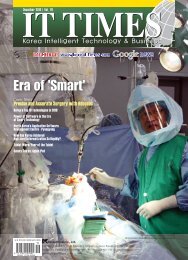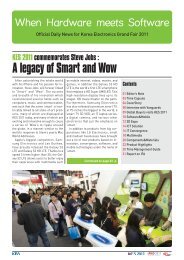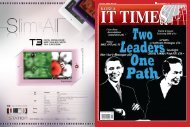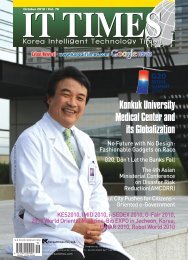is Coming to Korea - Korea IT Times
is Coming to Korea - Korea IT Times
is Coming to Korea - Korea IT Times
You also want an ePaper? Increase the reach of your titles
YUMPU automatically turns print PDFs into web optimized ePapers that Google loves.
Forecast<br />
The 21st century's living<br />
room might not just be a<br />
living space, but also<br />
a <strong>to</strong>tal multimedia space<br />
In the mid term, on the grounds that the global export market <strong>is</strong><br />
on shaky ground as there <strong>is</strong> likely <strong>to</strong> be a long way <strong>to</strong> go before<br />
the tumbled global trade goes back <strong>to</strong> pre-recession levels, the economic<br />
recovery, th<strong>is</strong> time around, will be milder. Facility investment<br />
<strong>is</strong> expected <strong>to</strong> post double-digit growth thanks <strong>to</strong> recoveries<br />
in consumption and exports and the low base effect.<br />
Au<strong>to</strong>mobiles, d<strong>is</strong>plays and semiconduc<strong>to</strong>rs are expected <strong>to</strong> spearhead<br />
growth in facility investments.<br />
Export gains and trade surpluses<br />
In 2010, the global economic recovery <strong>is</strong> projected <strong>to</strong> ramp up<br />
exports and imports. Despite a strong won, the US-led global economic<br />
recovery will help S. <strong>Korea</strong>'s exports climb around 13 percent.<br />
Imports are expected <strong>to</strong> soar as much as 20 percent, boosted<br />
by recovering domestic demand, r<strong>is</strong>ing international raw material<br />
prices, increased imports of intermediate goods (caused by export<br />
booms) and the low base effect from 2009. As imports are likely<br />
<strong>to</strong> outrun exports, S. <strong>Korea</strong>'s trade surplus would hover around<br />
US$ 24 billion, a steep fall from 2009.<br />
Cus<strong>to</strong>ms-cleared exports – which dropped 13.8 percent yearon-year<br />
<strong>to</strong> US$ 363.9 billion in 2009 – are expected <strong>to</strong> r<strong>is</strong>e 12.8<br />
percent <strong>to</strong> US$ 410.5 billion in 2010. On the other hand, cus<strong>to</strong>ms-cleared<br />
imports that shrank 16.7 percent <strong>to</strong> US$323.6 billion<br />
in 2009 are projected <strong>to</strong> zoom up by 19.6 percent <strong>to</strong> US$<br />
386.9 billion in 2010. S. <strong>Korea</strong>'s trade balance <strong>is</strong> expected <strong>to</strong><br />
dwindle <strong>to</strong> US$ 23.6 billion in 2010 from US$40.3 billion in 2009.<br />
The <strong>IT</strong> industry drives up domestic demand in<br />
manufacturing<br />
The release of Windows 7, the World Cup 2010 in South<br />
Africa, the expansion of smartphone markets, and increased demand<br />
for LED and solar cells are likely <strong>to</strong> boost domestic demand<br />
in the <strong>IT</strong> industry more than in any other industry.<br />
Sales of d<strong>is</strong>plays, in particular, are projected <strong>to</strong> surge 41 percent<br />
thanks <strong>to</strong> the low base effect and booming front-line industries. In<br />
the non-<strong>IT</strong> industry, domestic demand for general machinery and<br />
steel will gain 10 percent thanks <strong>to</strong> a rebound in construction and<br />
facility investments. And demand for textile and textile chemicals<br />
will slowly inch up, while that for au<strong>to</strong>mobiles and shipbuilding <strong>is</strong><br />
likely <strong>to</strong> be in the doldrums. Sales of au<strong>to</strong>mobiles are expected <strong>to</strong><br />
lose 1.4 percent due <strong>to</strong> weakened purchasing power resulting<br />
from mounting household debts and the expiration of "tax deductions<br />
for clunkers" program.<br />
Production of the <strong>IT</strong> industry <strong>is</strong> projected <strong>to</strong> pick up thanks <strong>to</strong><br />
gains in exports and imports. The low base effect and recoveries<br />
in exports and domestic demand will help most industries turn<br />
around. The <strong>IT</strong> industry will be the driving force behind the production<br />
growth in manufacturing. The production of d<strong>is</strong>plays <strong>is</strong><br />
likely <strong>to</strong> r<strong>is</strong>e 11.2 percent, while that of semiconduc<strong>to</strong>rs and information<br />
& communications equipment <strong>is</strong> predicted <strong>to</strong> increase 6-7<br />
percent. On the other hand, the production of home appliances <strong>is</strong><br />
forecast <strong>to</strong> gain a d<strong>is</strong>appointing 2.1 percent as the levying of individual<br />
consumption tax on home appliances puts a damper on<br />
the sales of big ticket items.<br />
Exports go up 10.8 percent<br />
Although a strong won can put downward pressure, exports<br />
are expected <strong>to</strong> jump 10.8 percent, remaining similar <strong>to</strong> 2008 levels,<br />
as exports <strong>to</strong> emerging markets, led by China, continue <strong>to</strong><br />
grow. The <strong>IT</strong> industry – whose exports are expected <strong>to</strong> climb<br />
15.2 percent thanks <strong>to</strong> such improvements in export conditions<br />
as the World Cup 2010 in South Africa and the launch of<br />
Windows 7 - <strong>is</strong> likely <strong>to</strong> lead export activities in manufacturing.<br />
Exports of semiconduc<strong>to</strong>rs, d<strong>is</strong>plays, information & communications<br />
equipment, and home appliances are expected <strong>to</strong> advance<br />
17.0 percent, 15.1 percent, 14.3 percent and 13.4 percent respectively.<br />
Of the <strong>to</strong>tal exports, the combined share of shipbuilding,<br />
information & communications equipment, au<strong>to</strong>mobiles, and<br />
semiconduc<strong>to</strong>rs <strong>is</strong> forecast <strong>to</strong> amount <strong>to</strong> 41 percent. Each of the<br />
four industries has an around 10 percent share of the <strong>to</strong>tal exports.<br />
Imports go up 12.4 percent<br />
In 2010, the revenues of the <strong>to</strong>p 10 major industries are projected<br />
<strong>to</strong> gain 12.4 percent due <strong>to</strong> the low base effect from 2009<br />
when their revenues tumbled 24 percent, but still they are expected<br />
<strong>to</strong> fall short of 2008 levels.<br />
The <strong>IT</strong> industry's imports will r<strong>is</strong>e 14.8 percent, boosted by increased<br />
demand for parts imports for export goods, growing reimwww.koreaittimes.com<br />
13


